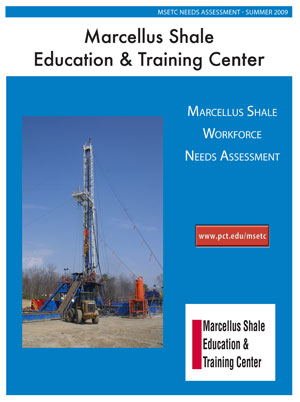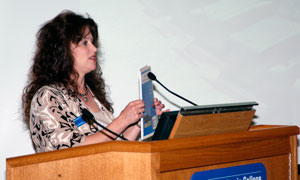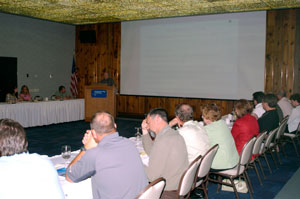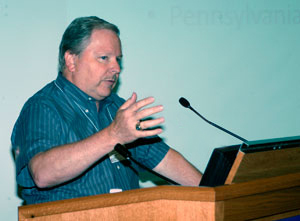 The developing natural-gas industry in Pennsylvania will create jobs and offer opportunities for local residents who seek training and industry experience, according to the Marcellus Shale Workforce Needs Assessment released Tuesday.
The developing natural-gas industry in Pennsylvania will create jobs and offer opportunities for local residents who seek training and industry experience, according to the Marcellus Shale Workforce Needs Assessment released Tuesday.
The needs assessment was conducted by the Marcellus Shale Education & Training Center (MSETC), a partnership between Pennsylvania College of Technology and Penn State Cooperative Extension, with additional funding from the Pennsylvania Department of Labor and Industry provided through the Central Pennsylvania Workforce Development Corp. and the Northern Tier Regional Planning and Development Commission.
The report suggests that, depending on the intensity of development, between 1,292 and 2,153 direct, full-time jobs could be required in the Northern Tier (Bradford, Sullivan, Susquehanna, Tioga and Wyoming counties) this year to support well drilling and production. The number of jobs is expected to grow to between 2,107 and 3,511 by 2011 and to between 3,281 and 5,468 by 2013.
In the Central Region (Centre, Clinton, Columbia, Lycoming, Mifflin, Montour, Northumberland, Snyder and Union counties), between 325 and 542 direct, full-time jobs are projected in 2009; that number is expected to increase to between 1,347 and 2,245 in 2011-13 as drilling intensifies in this region.
In addition to these direct-employment projections, the Pennsylvania Economy League recently estimated that each direct job in the Pennsylvania oil-and-gas industry creates an additional 1.52 indirect jobs throughout the economy.
"The development of the industry ultimately determines the number of jobs that will be introduced to the region," said Larry L. Michael, executive director of workforce and economic development at Penn College. "The data collected by the MSETC team indicates that development levels are intensifying in both the northern and central regions."
Because most companies and workers have not yet located in the region, a challenge of the study was determining where companies might base their operations. Natural-gas industry companies are known for commuting long distances and quickly changing the locations of offices, yards and staging areas. It is not yet known how far workers will be willing to travel to work in the Northern Tier and Central Region, but early in the development stage, several areas emerged with the greatest potential to host many of the major companies and workers. They are: Williamsport, Towanda and Horseheads, N.Y.
 "Since 2007, 94 wells have been drilled in the Northern Tier and 32 in the Central Region. As of this month, 435 permits were issued in the Northern Tier and 123 in the Central Region. Projections suggest that, in the most likely scenario, the number of wells drilled per year will rise to 356 in the Northern Tier and 146 in the Central Region by 2013. High and low projections for the regions range between 267 and 445 in the Northern Tier and between 110 and 183 in the Central Region.
"Since 2007, 94 wells have been drilled in the Northern Tier and 32 in the Central Region. As of this month, 435 permits were issued in the Northern Tier and 123 in the Central Region. Projections suggest that, in the most likely scenario, the number of wells drilled per year will rise to 356 in the Northern Tier and 146 in the Central Region by 2013. High and low projections for the regions range between 267 and 445 in the Northern Tier and between 110 and 183 in the Central Region.
The MSETC workforce-projection model suggests that approximately 410 individuals in 150 different occupations are required to develop and drill a single well in the Marcellus Shale. The total of number of hours worked by these individuals on a single well is the equivalent of 11.5 full-time jobs over the course of the year.
The actual workforce needed will fluctuate during the drilling or "boom" stage, depending upon how many wells are drilled per year, the report states. Ninety-eight percent of the jobs are required only until the well is completed; these do not continue into the production phase, which requires fewer, but more long-term positions.
"For example, if 100 wells are drilled each year for 10 years, 17 production jobs would be created each year," the report says. "Most of these workers would be based at company offices near well locations."
 The industry will not meet all its needs with local workers. The needs assessment states, "Energy companies and contractors that perform this type of drilling are mostly national or international in size, and subsequently utilize contractors and personnel from around the country and from other parts of the world to perform some of this work."
The industry will not meet all its needs with local workers. The needs assessment states, "Energy companies and contractors that perform this type of drilling are mostly national or international in size, and subsequently utilize contractors and personnel from around the country and from other parts of the world to perform some of this work."
The report goes on to describe how the nature of the industry creates unique workforce requirements: "Employees are often based from multiple locations within a region to develop hundreds of different wells' pipeline, and compressor station locations. Many industry workers do not work conventional schedules and often work on rotation. Workers will sometimes work 12-hour shifts for weeks at a time, and then be afforded several continuous weeks of leave while an entirely new crew of workers takes their place."
The movement of temporary workers through the area creates opportunities for businesses that service the workers' needs (hotels, motels, campgrounds, restaurants, etc.) and also may create interest among local residents who want to pursue the travel opportunities and financial rewards of the industry.
The needs assessment found that 75 percent of the natural-gas industry's workforce comprises jobs that require experience-driven skills and knowledge specific to the natural-gas industry. Most of these positions do not require formal postsecondary education; some do require trade certifications. Those who want to seek advancement in the industry will benefit from more advanced education.
Occupations involved with the development of the natural-gas industry represent a wide range of career opportunities from welders, heavy equipment operators, commercial drivers and loggers to X-ray technicians, geologists, engineers, inspectors, supervisors, office workers, paralegals and lawyers.
"Many of these jobs are family-sustaining positions, with relatively high wages," said Thomas Murphy, Penn State Cooperative Extension educator and member of the MSETC team. "It is critical that educational institutions be prepared to help Pennsylvanians learn the skills necessary to get these jobs."
 Many of the employment opportunities will be with service businesses that work directly with the natural-gas companies and with existing businesses that will benefit from more dollars circulating in the economy. As new companies move into the region, it is expected that they will look for local workers to fill their needs.
Many of the employment opportunities will be with service businesses that work directly with the natural-gas companies and with existing businesses that will benefit from more dollars circulating in the economy. As new companies move into the region, it is expected that they will look for local workers to fill their needs.
"Over the course of time, we've seen a migration of youth out of the area because they feel they have to leave to find good jobs," Murphy said. "This will be an opportunity where more of our youth can find good employment here within the region, allowing them to stay where they grew up."
The availability of local education and training also will support the developing industry and the local residents interested in securing employment in the field.
"The study found that the Central and Northern Tier Regions offer both secondary and postsecondary education and training programs sufficient to meet some of the industry needs," Michael said. "In most cases, for each occupational need in the industry, there is a direct match with one of the region's colleges or career and technical schools. In cases where there is not a direct match, program development is under way to offer the required programs for both the community and the industry."
Penn College President Davie Jane Gilmour said, "The needs assessment provided valuable information to help educators identify programs and services that will provide area residents the opportunity to develop the skills needed to compete for natural-gas industry jobs that could become available in the Northern Tier and Central Regions."
The Marcellus Shale Education & Training Center opened in January in the Center for Business & Workforce Development on the Penn College campus in Williamsport. It serves as a central resource for workforce-development and community-education needs for the industry. The MSETC has the capacity to deliver services through Penn College, Penn State and 33 other institutions, including community colleges and state universities that are part of WEDnetPA, a system administered by Penn College to provide training to companies and employees across Pennsylvania.
A complete copy of the needs assessment and other information is available online .
